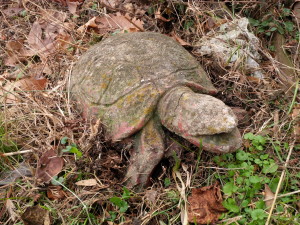 Christine Schoene Maccabee
Christine Schoene Maccabee
Hibernation: A state of being during extreme cold, forcing many creatures to become dormant in their hibernacula (their winter quarters or place of retirement…Florida?).
It’s winter. It’s very cold. Climbing out of my warm nest to put a log on the fire, I feel like a turtle in its shell. I would much rather just stay under my warm covers and hibernate!
My theory is this: it is natural for warm-blooded humans to slow down in cold weather. I will call it the burrowing impulse. I suppose this goes against many other theories that suggest that humans need to speed up and keep the blood flowing to keep warm, but somehow this does not always work for me. So, I resort to a cup of coffee in the morning—as many of us do—and pasta dishes, which become increasingly important for energy. Then there are energy bars and some strongly caffeinated drinks, which are really not good for people. Sometimes plain old inspiration provides motivation to get going, and then there is always the fear of loosing one’s job if late for work. Perhaps the most popular incentive is the pleasure of foraging for food at a favorite local market place. One way or the other, warm-blooded humans rally to the cause of living in this human world we have created.
After running around, doing all the outdoor chores on this icy, windy day, all I want to do is lay down and curl up with a good book, or a good man if I had one, and relax. My fingers and feet are cold, and I am lethargic. Is lethargy a form of mental hibernation? There are many types of dormant conditions in the natural world. So I contemplate hibernation, and how nice it would be if only….if only I were a bear or a coon or a snake or a turtle. However, in my reading on the subject, I have learned that many critters do not really go into true hibernation. Such is the case for most bears, especially the polar bear, for the female usually births her cubs, cleaning and feeding them, during hibernation. The male is usually out fishing!
Here in the mountains where I live I am thankful that the black snake, by now in deep hibernation, is no longer after my chicken eggs; although, fewer eggs are laid due to the cold, shorter days. Perhaps I should get solar panels on the roof of the coop as a source of electricity. Not a bad idea. The woodchucks have happily withdrawn into seclusion, dormant in their burrows. Their breathing and heart rates are slowed and body temperatures lowered. I am happy—no, thrilled—not to see them! Of course, they are now no threat to the vegetables in my gardens, as there is nothing growing right now, except for the salad bar in my cold frames, which I mostly keep closed from the weather.
One thing I always miss throughout the winter is the wonderful music of crickets, katydids, frogs, and toads; I must patiently await their emergence from sleep. Spring cannot come soon enough for most of us, but winter is a necessary time of renewal. Most seeds need stratification, or a period of deep freeze, in order to germinate in the spring. Also, many pests who do not manage to sneak into your house or find a warm place to hide, will die off. I am thinking specifically of the infamous stink bug!
Of course, the butterflies have disappeared, too. Some, like the Monarchs, migrate south. However, one tough cookie, the Mourning Cloak, spends the winter in hollow trees and some live to “talk “ about it. I wonder what they would say about their time in the tree all winter. Maybe something like “Boring!” Same goes for moths, which are in the pupa stage, all wrapped up in cocoons. I am beginning to wonder if I really want to hibernate. Maybe I should go south, but one needs money for that, plus I really am not retired, and likely never will be.
I would be remiss if I did not mention turtles, one of my very favorite animals. A good friend of mine who lives in Northern Minnesota, where temperatures have already been down as low as -25 degrees, said in an email that he does not know how turtles manage to survive winters there. Most winters, the ground freezes anywhere between three and six feet down. So how does the soft body of the turtle, encased in a thin shell, manage not to turn into an ice cube? This has always been my question, too. Perhaps we should just chalk it up to one of those great mysteries of life. Any theories?
Not all turtles manage to emerge from the ground in the spring, as was the case of Timothy in a semi-true story by Verlyn Klinkenborg. Told from the turtle’s perspective, his last thoughts were, as recorded in the book: “I dig and dig. Settle the dirt on my shell. As deep as I can go into the warmth of earth. Carefully overlaid with autumn’s debris. Anchored. Immured. Landlocked. Becalmed…” and never to rise again from his hibernaculum, dead about the age of sixty.
I believe I shall be content with that cup of coffee in the morning as I watch the snow fall; with finding delight in the variety of birds eating black sunflowers at my feeder; with taking that brisk, life-giving walk to care for my chickens; and with singing “Silver Bells” as I give thanks for being a warm-blooded human being.
Many Blessings to all.

